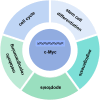Regulatory role of transcription factor c-Myc in the pathogenesis of psoriasis
- PMID: 40718778
- PMCID: PMC12292300
- DOI: 10.7717/peerj.19706
Regulatory role of transcription factor c-Myc in the pathogenesis of psoriasis
Abstract
Psoriasis is a chronic relapsing dermatosis characterized by hyperproliferation and poor differentiation of keratinocytes (KCs). The c-Myc gene is one of the main members of the Myc family and exerts multiple biological functions. C-Myc is highly expressed in psoriatic lesions. The co-expressed genes and coexisting factors of c-Myc determine the final survival of cells. The high expression levels of c-Myc in the skin lesions of psoriatic patients are associated with the continuous proliferation of KCs, and form an abnormal state of epidermal dynamics. C-Myc is also involved in the induction of metabolic reprogramming of cells in the development of psoriasis, thus exacerbating the excessive proliferation of psoriatic epidermis. In this review, we focus on the mechanisms of the transcription factor c-Myc in the pathogenesis of psoriasis and its clinical implications.
Keywords: Keratinocytes; Metabolic reprogramming; Proliferation; Psoriasis; c-Myc.
©2025 Cao et al.
Conflict of interest statement
The authors declare there are no competing interests.
Figures



Similar articles
-
FOXE1 Contributes to the Development of Psoriasis by Regulating WNT5A.J Invest Dermatol. 2023 Dec;143(12):2366-2377.e7. doi: 10.1016/j.jid.2023.04.035. Epub 2023 Jun 30. J Invest Dermatol. 2023. PMID: 37394057
-
FBP1 orchestrates keratinocyte proliferation/differentiation and suppresses psoriasis through metabolic control of histone acetylation.Cell Death Dis. 2024 Jun 4;15(6):392. doi: 10.1038/s41419-024-06706-6. Cell Death Dis. 2024. PMID: 38834617 Free PMC article.
-
LncRNA LINC01026 Is Overexpressed in Psoriasis and Enhances Keratinocyte Cell Cycle Progression by Regulating the Ets Homologous Factor (EHF).J Cell Mol Med. 2025 Jul;29(14):e70719. doi: 10.1111/jcmm.70719. J Cell Mol Med. 2025. PMID: 40670887 Free PMC article.
-
Role of an imbalanced miRNAs axis in pathogenesis of psoriasis: novel perspectives based on review of the literature.Oncotarget. 2017 Jan 17;8(3):5498-5507. doi: 10.18632/oncotarget.12534. Oncotarget. 2017. PMID: 27729619 Free PMC article.
-
Systemic pharmacological treatments for chronic plaque psoriasis: a network meta-analysis.Cochrane Database Syst Rev. 2017 Dec 22;12(12):CD011535. doi: 10.1002/14651858.CD011535.pub2. Cochrane Database Syst Rev. 2017. Update in: Cochrane Database Syst Rev. 2020 Jan 9;1:CD011535. doi: 10.1002/14651858.CD011535.pub3. PMID: 29271481 Free PMC article. Updated.
References
-
- Askew DS, Ashmun RA, Simmons BC, Cleveland JL. Constitutive c-myc expression in an IL-3-dependent myeloid cell line suppresses cell cycle arrest and accelerates apoptosis. Oncogene. 1991;6:1915–1922. - PubMed
-
- Ba J, Han P, Yuan G, Mo Z, Pan C, Wu F, Xu L, Hanson ME, Engel SS, Shankar RR. Randomized trial assessing the safety and efficacy of sitagliptin in Chinese patients with type 2 diabetes mellitus inadequately controlled on sulfonylurea alone or combined with metformin. Journal of Diabetes. 2016;9(7):667–676. doi: 10.1111/1753-0407.12456. - DOI - PubMed
Publication types
MeSH terms
Substances
LinkOut - more resources
Full Text Sources
Medical

